ACCT20075: Detailed Audit Report on Magellan Financial Group (MFG)
VerifiedAdded on 2023/01/16
|12
|2850
|72
Report
AI Summary
This report presents an in-depth analysis of the audit of Magellan Financial Group (MFG). It begins with an introduction to audit concepts, particularly materiality, and its significance in financial statements. The report then examines MFG's audit, including the company's operations, the role of Ernst & Young, and the quantitative estimation of materiality. It delves into specific areas such as investment valuation, business combinations, and financial ratios, providing a detailed assessment of the company's financial stability and performance. The cash flow statement is also examined, along with non-cash financial activities and the assessment of going concern risk. Finally, the report considers the opinions expressed by the auditors, offering a comprehensive overview of the audit process and its key findings.
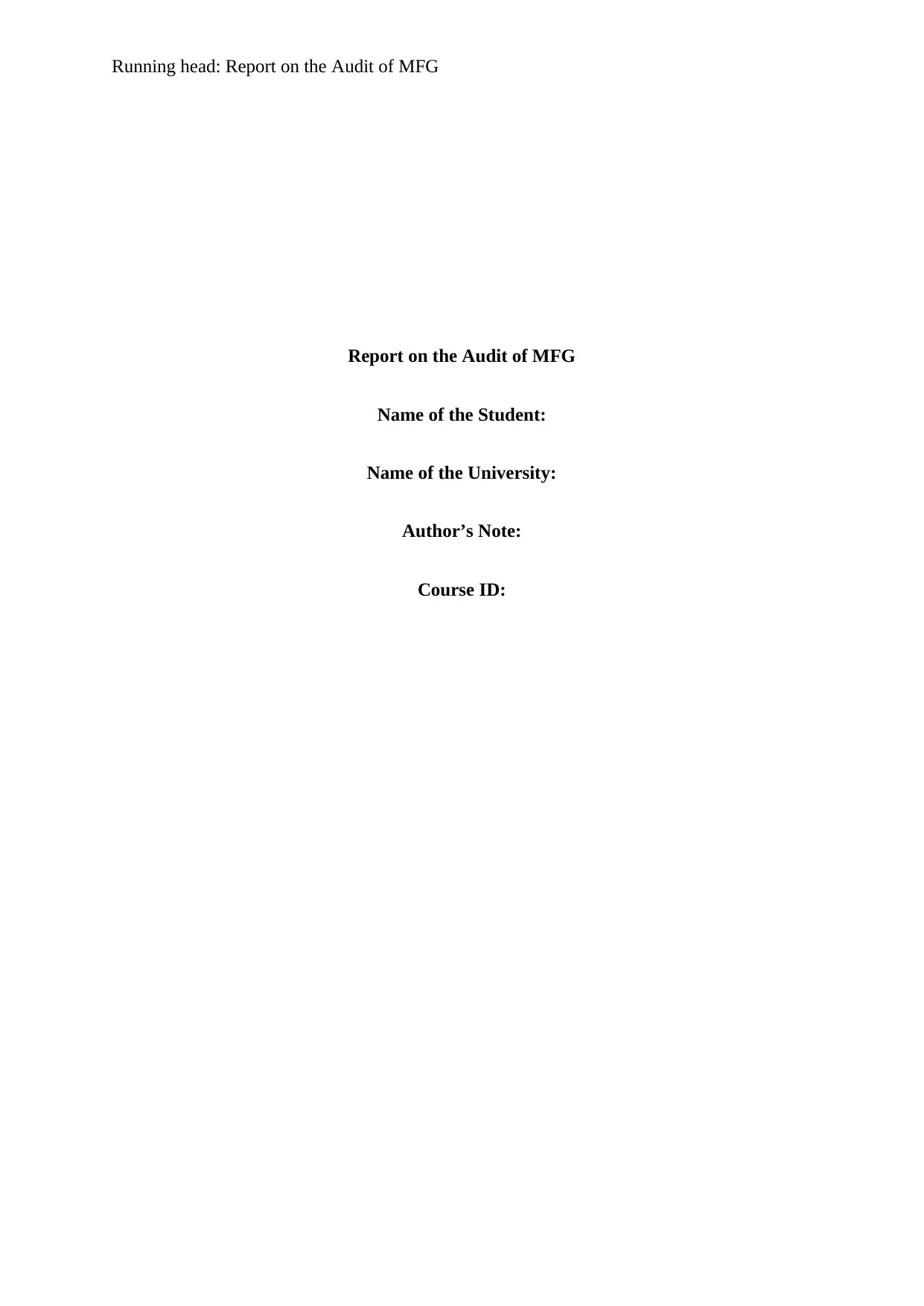
Running head: Report on the Audit of MFG
Report on the Audit of MFG
Name of the Student:
Name of the University:
Author’s Note:
Course ID:
Report on the Audit of MFG
Name of the Student:
Name of the University:
Author’s Note:
Course ID:
Paraphrase This Document
Need a fresh take? Get an instant paraphrase of this document with our AI Paraphraser
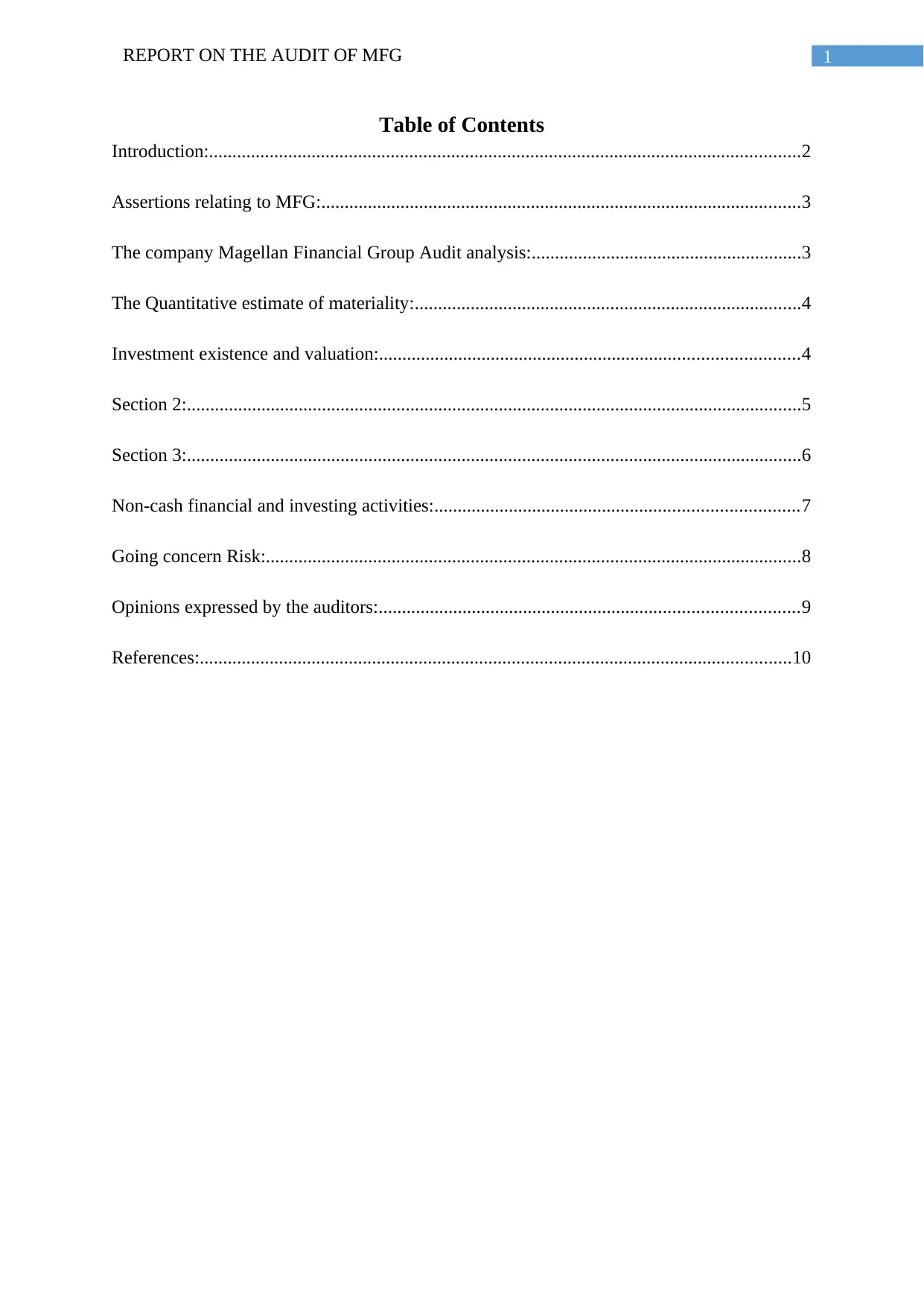
1REPORT ON THE AUDIT OF MFG
Table of Contents
Introduction:...............................................................................................................................2
Assertions relating to MFG:.......................................................................................................3
The company Magellan Financial Group Audit analysis:..........................................................3
The Quantitative estimate of materiality:...................................................................................4
Investment existence and valuation:..........................................................................................4
Section 2:....................................................................................................................................5
Section 3:....................................................................................................................................6
Non-cash financial and investing activities:..............................................................................7
Going concern Risk:...................................................................................................................8
Opinions expressed by the auditors:..........................................................................................9
References:...............................................................................................................................10
Table of Contents
Introduction:...............................................................................................................................2
Assertions relating to MFG:.......................................................................................................3
The company Magellan Financial Group Audit analysis:..........................................................3
The Quantitative estimate of materiality:...................................................................................4
Investment existence and valuation:..........................................................................................4
Section 2:....................................................................................................................................5
Section 3:....................................................................................................................................6
Non-cash financial and investing activities:..............................................................................7
Going concern Risk:...................................................................................................................8
Opinions expressed by the auditors:..........................................................................................9
References:...............................................................................................................................10
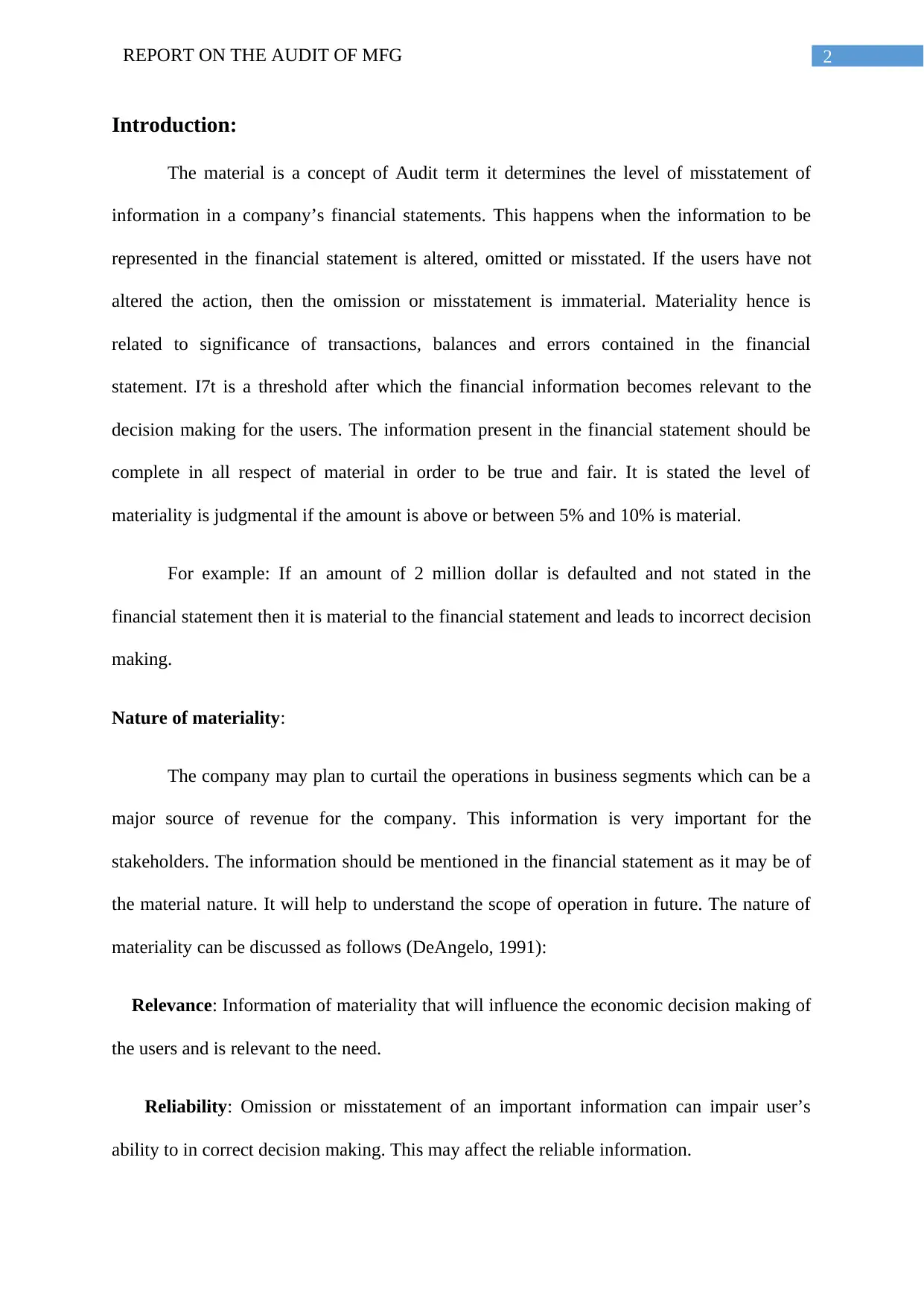
2REPORT ON THE AUDIT OF MFG
Introduction:
The material is a concept of Audit term it determines the level of misstatement of
information in a company’s financial statements. This happens when the information to be
represented in the financial statement is altered, omitted or misstated. If the users have not
altered the action, then the omission or misstatement is immaterial. Materiality hence is
related to significance of transactions, balances and errors contained in the financial
statement. I7t is a threshold after which the financial information becomes relevant to the
decision making for the users. The information present in the financial statement should be
complete in all respect of material in order to be true and fair. It is stated the level of
materiality is judgmental if the amount is above or between 5% and 10% is material.
For example: If an amount of 2 million dollar is defaulted and not stated in the
financial statement then it is material to the financial statement and leads to incorrect decision
making.
Nature of materiality:
The company may plan to curtail the operations in business segments which can be a
major source of revenue for the company. This information is very important for the
stakeholders. The information should be mentioned in the financial statement as it may be of
the material nature. It will help to understand the scope of operation in future. The nature of
materiality can be discussed as follows (DeAngelo, 1991):
Relevance: Information of materiality that will influence the economic decision making of
the users and is relevant to the need.
Reliability: Omission or misstatement of an important information can impair user’s
ability to in correct decision making. This may affect the reliable information.
Introduction:
The material is a concept of Audit term it determines the level of misstatement of
information in a company’s financial statements. This happens when the information to be
represented in the financial statement is altered, omitted or misstated. If the users have not
altered the action, then the omission or misstatement is immaterial. Materiality hence is
related to significance of transactions, balances and errors contained in the financial
statement. I7t is a threshold after which the financial information becomes relevant to the
decision making for the users. The information present in the financial statement should be
complete in all respect of material in order to be true and fair. It is stated the level of
materiality is judgmental if the amount is above or between 5% and 10% is material.
For example: If an amount of 2 million dollar is defaulted and not stated in the
financial statement then it is material to the financial statement and leads to incorrect decision
making.
Nature of materiality:
The company may plan to curtail the operations in business segments which can be a
major source of revenue for the company. This information is very important for the
stakeholders. The information should be mentioned in the financial statement as it may be of
the material nature. It will help to understand the scope of operation in future. The nature of
materiality can be discussed as follows (DeAngelo, 1991):
Relevance: Information of materiality that will influence the economic decision making of
the users and is relevant to the need.
Reliability: Omission or misstatement of an important information can impair user’s
ability to in correct decision making. This may affect the reliable information.
⊘ This is a preview!⊘
Do you want full access?
Subscribe today to unlock all pages.

Trusted by 1+ million students worldwide
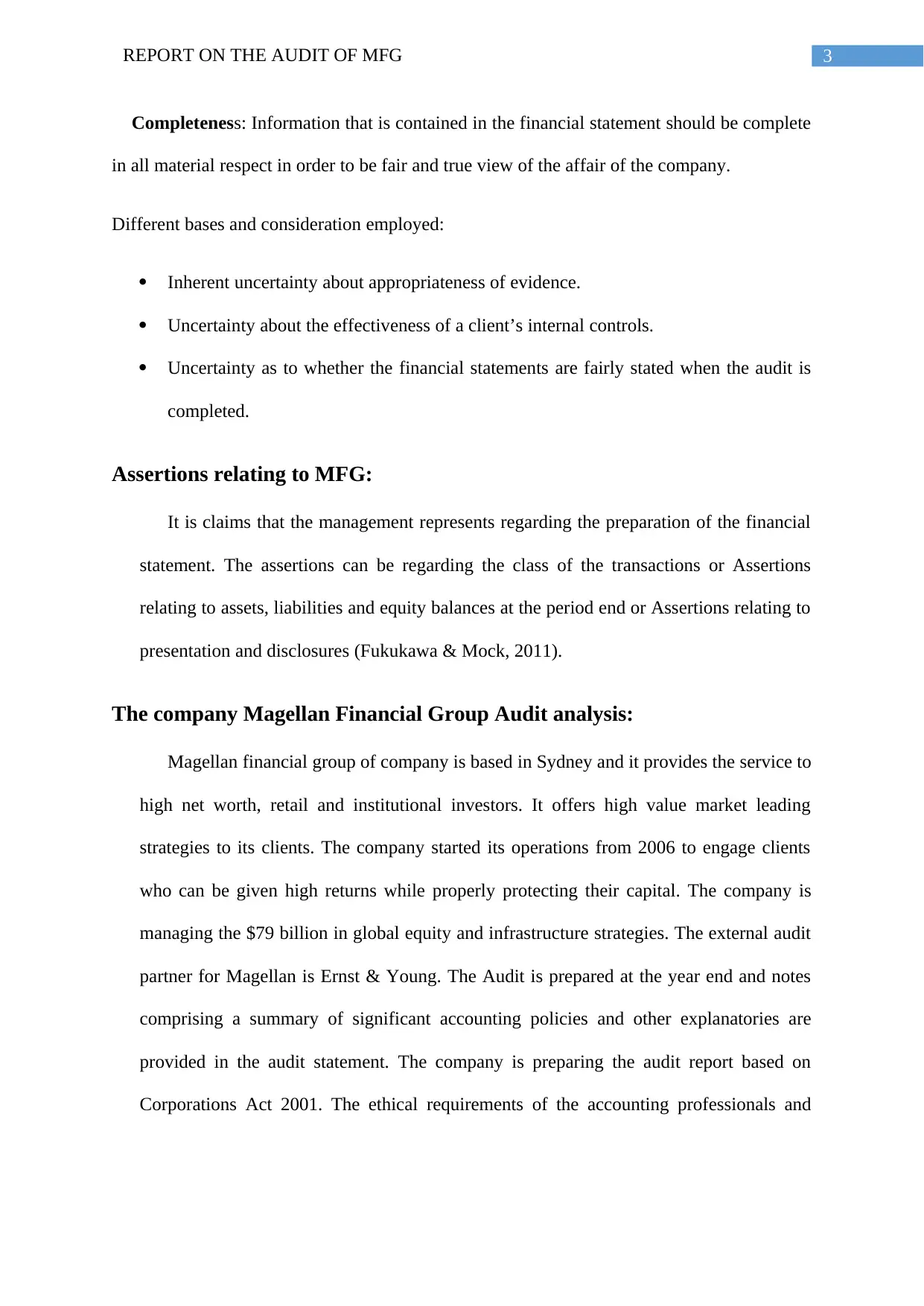
3REPORT ON THE AUDIT OF MFG
Completeness: Information that is contained in the financial statement should be complete
in all material respect in order to be fair and true view of the affair of the company.
Different bases and consideration employed:
Inherent uncertainty about appropriateness of evidence.
Uncertainty about the effectiveness of a client’s internal controls.
Uncertainty as to whether the financial statements are fairly stated when the audit is
completed.
Assertions relating to MFG:
It is claims that the management represents regarding the preparation of the financial
statement. The assertions can be regarding the class of the transactions or Assertions
relating to assets, liabilities and equity balances at the period end or Assertions relating to
presentation and disclosures (Fukukawa & Mock, 2011).
The company Magellan Financial Group Audit analysis:
Magellan financial group of company is based in Sydney and it provides the service to
high net worth, retail and institutional investors. It offers high value market leading
strategies to its clients. The company started its operations from 2006 to engage clients
who can be given high returns while properly protecting their capital. The company is
managing the $79 billion in global equity and infrastructure strategies. The external audit
partner for Magellan is Ernst & Young. The Audit is prepared at the year end and notes
comprising a summary of significant accounting policies and other explanatories are
provided in the audit statement. The company is preparing the audit report based on
Corporations Act 2001. The ethical requirements of the accounting professionals and
Completeness: Information that is contained in the financial statement should be complete
in all material respect in order to be fair and true view of the affair of the company.
Different bases and consideration employed:
Inherent uncertainty about appropriateness of evidence.
Uncertainty about the effectiveness of a client’s internal controls.
Uncertainty as to whether the financial statements are fairly stated when the audit is
completed.
Assertions relating to MFG:
It is claims that the management represents regarding the preparation of the financial
statement. The assertions can be regarding the class of the transactions or Assertions
relating to assets, liabilities and equity balances at the period end or Assertions relating to
presentation and disclosures (Fukukawa & Mock, 2011).
The company Magellan Financial Group Audit analysis:
Magellan financial group of company is based in Sydney and it provides the service to
high net worth, retail and institutional investors. It offers high value market leading
strategies to its clients. The company started its operations from 2006 to engage clients
who can be given high returns while properly protecting their capital. The company is
managing the $79 billion in global equity and infrastructure strategies. The external audit
partner for Magellan is Ernst & Young. The Audit is prepared at the year end and notes
comprising a summary of significant accounting policies and other explanatories are
provided in the audit statement. The company is preparing the audit report based on
Corporations Act 2001. The ethical requirements of the accounting professionals and
Paraphrase This Document
Need a fresh take? Get an instant paraphrase of this document with our AI Paraphraser
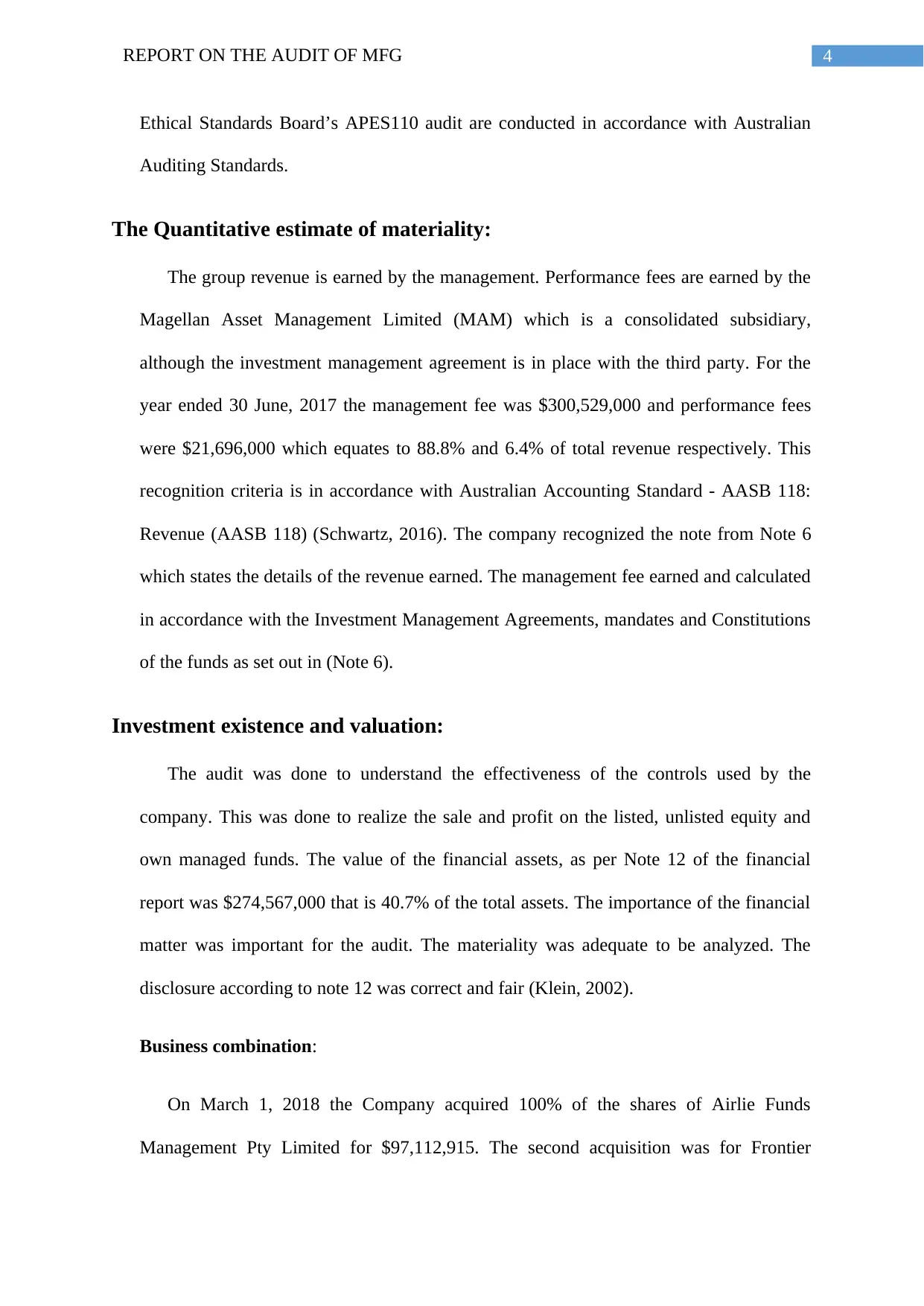
4REPORT ON THE AUDIT OF MFG
Ethical Standards Board’s APES110 audit are conducted in accordance with Australian
Auditing Standards.
The Quantitative estimate of materiality:
The group revenue is earned by the management. Performance fees are earned by the
Magellan Asset Management Limited (MAM) which is a consolidated subsidiary,
although the investment management agreement is in place with the third party. For the
year ended 30 June, 2017 the management fee was $300,529,000 and performance fees
were $21,696,000 which equates to 88.8% and 6.4% of total revenue respectively. This
recognition criteria is in accordance with Australian Accounting Standard - AASB 118:
Revenue (AASB 118) (Schwartz, 2016). The company recognized the note from Note 6
which states the details of the revenue earned. The management fee earned and calculated
in accordance with the Investment Management Agreements, mandates and Constitutions
of the funds as set out in (Note 6).
Investment existence and valuation:
The audit was done to understand the effectiveness of the controls used by the
company. This was done to realize the sale and profit on the listed, unlisted equity and
own managed funds. The value of the financial assets, as per Note 12 of the financial
report was $274,567,000 that is 40.7% of the total assets. The importance of the financial
matter was important for the audit. The materiality was adequate to be analyzed. The
disclosure according to note 12 was correct and fair (Klein, 2002).
Business combination:
On March 1, 2018 the Company acquired 100% of the shares of Airlie Funds
Management Pty Limited for $97,112,915. The second acquisition was for Frontier
Ethical Standards Board’s APES110 audit are conducted in accordance with Australian
Auditing Standards.
The Quantitative estimate of materiality:
The group revenue is earned by the management. Performance fees are earned by the
Magellan Asset Management Limited (MAM) which is a consolidated subsidiary,
although the investment management agreement is in place with the third party. For the
year ended 30 June, 2017 the management fee was $300,529,000 and performance fees
were $21,696,000 which equates to 88.8% and 6.4% of total revenue respectively. This
recognition criteria is in accordance with Australian Accounting Standard - AASB 118:
Revenue (AASB 118) (Schwartz, 2016). The company recognized the note from Note 6
which states the details of the revenue earned. The management fee earned and calculated
in accordance with the Investment Management Agreements, mandates and Constitutions
of the funds as set out in (Note 6).
Investment existence and valuation:
The audit was done to understand the effectiveness of the controls used by the
company. This was done to realize the sale and profit on the listed, unlisted equity and
own managed funds. The value of the financial assets, as per Note 12 of the financial
report was $274,567,000 that is 40.7% of the total assets. The importance of the financial
matter was important for the audit. The materiality was adequate to be analyzed. The
disclosure according to note 12 was correct and fair (Klein, 2002).
Business combination:
On March 1, 2018 the Company acquired 100% of the shares of Airlie Funds
Management Pty Limited for $97,112,915. The second acquisition was for Frontier
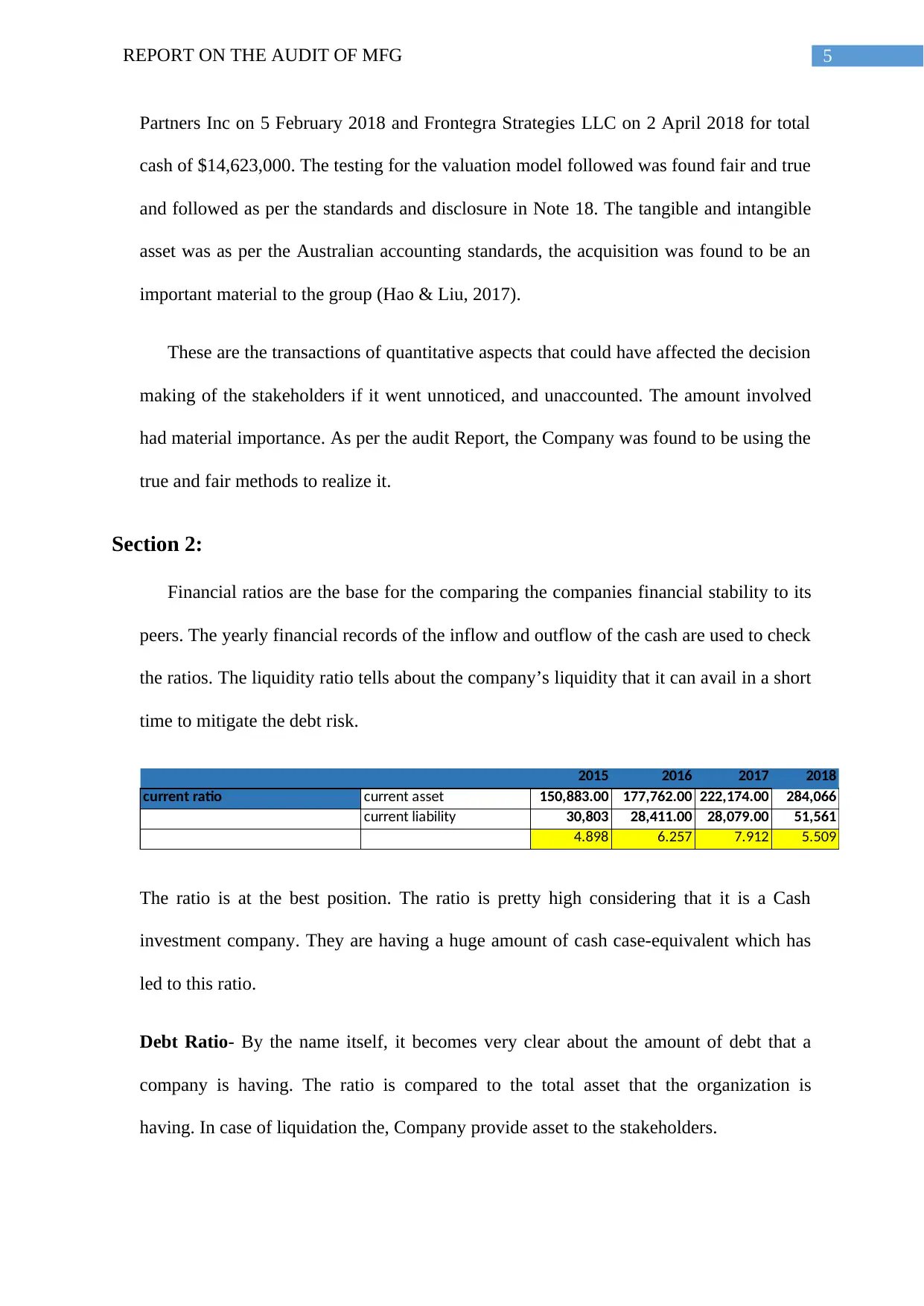
5REPORT ON THE AUDIT OF MFG
Partners Inc on 5 February 2018 and Frontegra Strategies LLC on 2 April 2018 for total
cash of $14,623,000. The testing for the valuation model followed was found fair and true
and followed as per the standards and disclosure in Note 18. The tangible and intangible
asset was as per the Australian accounting standards, the acquisition was found to be an
important material to the group (Hao & Liu, 2017).
These are the transactions of quantitative aspects that could have affected the decision
making of the stakeholders if it went unnoticed, and unaccounted. The amount involved
had material importance. As per the audit Report, the Company was found to be using the
true and fair methods to realize it.
Section 2:
Financial ratios are the base for the comparing the companies financial stability to its
peers. The yearly financial records of the inflow and outflow of the cash are used to check
the ratios. The liquidity ratio tells about the company’s liquidity that it can avail in a short
time to mitigate the debt risk.
2015 2016 2017 2018
current ratio current asset 150,883.00 177,762.00 222,174.00 284,066
current liability 30,803 28,411.00 28,079.00 51,561
4.898 6.257 7.912 5.509
The ratio is at the best position. The ratio is pretty high considering that it is a Cash
investment company. They are having a huge amount of cash case-equivalent which has
led to this ratio.
Debt Ratio- By the name itself, it becomes very clear about the amount of debt that a
company is having. The ratio is compared to the total asset that the organization is
having. In case of liquidation the, Company provide asset to the stakeholders.
Partners Inc on 5 February 2018 and Frontegra Strategies LLC on 2 April 2018 for total
cash of $14,623,000. The testing for the valuation model followed was found fair and true
and followed as per the standards and disclosure in Note 18. The tangible and intangible
asset was as per the Australian accounting standards, the acquisition was found to be an
important material to the group (Hao & Liu, 2017).
These are the transactions of quantitative aspects that could have affected the decision
making of the stakeholders if it went unnoticed, and unaccounted. The amount involved
had material importance. As per the audit Report, the Company was found to be using the
true and fair methods to realize it.
Section 2:
Financial ratios are the base for the comparing the companies financial stability to its
peers. The yearly financial records of the inflow and outflow of the cash are used to check
the ratios. The liquidity ratio tells about the company’s liquidity that it can avail in a short
time to mitigate the debt risk.
2015 2016 2017 2018
current ratio current asset 150,883.00 177,762.00 222,174.00 284,066
current liability 30,803 28,411.00 28,079.00 51,561
4.898 6.257 7.912 5.509
The ratio is at the best position. The ratio is pretty high considering that it is a Cash
investment company. They are having a huge amount of cash case-equivalent which has
led to this ratio.
Debt Ratio- By the name itself, it becomes very clear about the amount of debt that a
company is having. The ratio is compared to the total asset that the organization is
having. In case of liquidation the, Company provide asset to the stakeholders.
⊘ This is a preview!⊘
Do you want full access?
Subscribe today to unlock all pages.

Trusted by 1+ million students worldwide
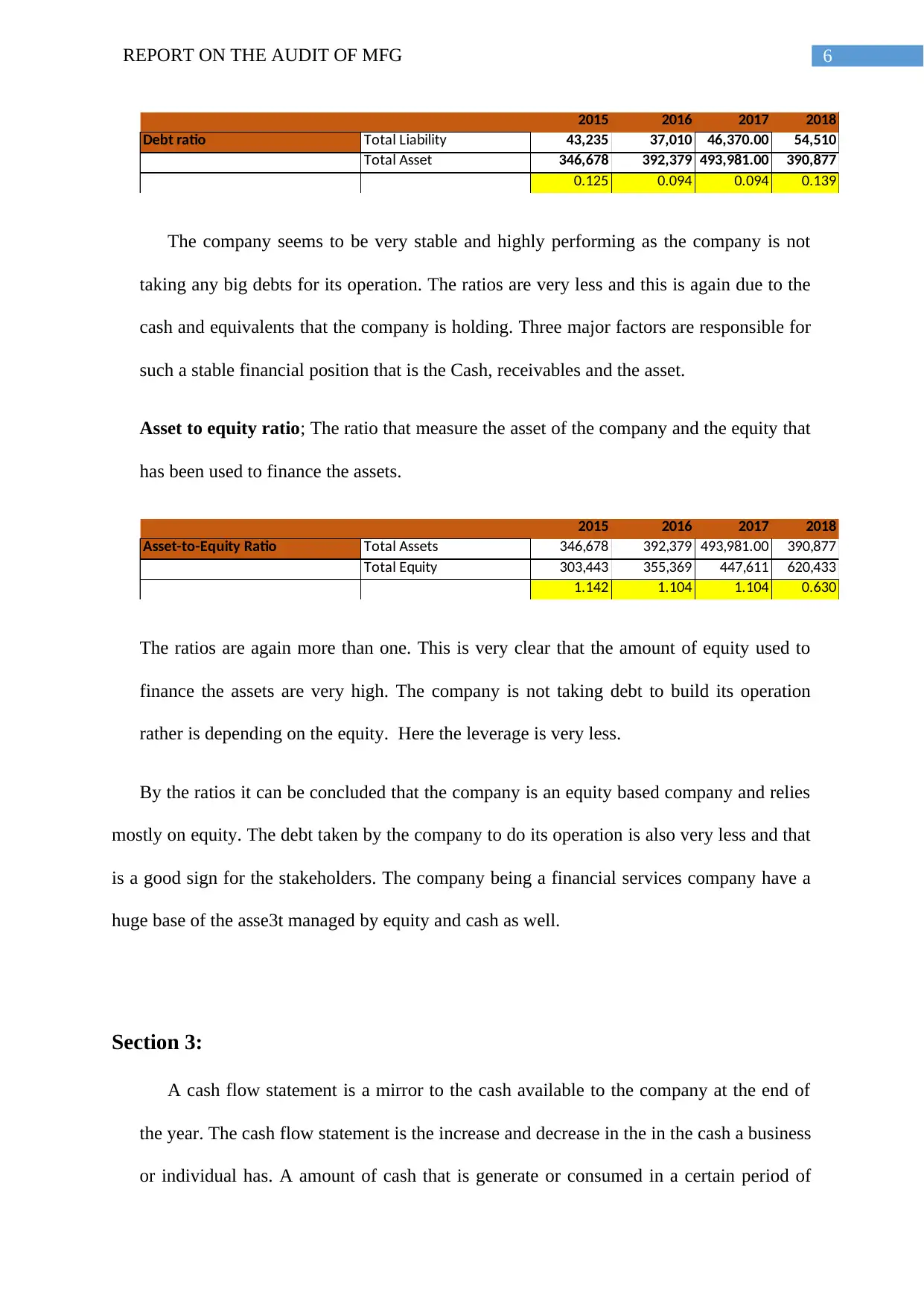
6REPORT ON THE AUDIT OF MFG
2015 2016 2017 2018
Debt ratio Total Liability 43,235 37,010 46,370.00 54,510
Total Asset 346,678 392,379 493,981.00 390,877
0.125 0.094 0.094 0.139
The company seems to be very stable and highly performing as the company is not
taking any big debts for its operation. The ratios are very less and this is again due to the
cash and equivalents that the company is holding. Three major factors are responsible for
such a stable financial position that is the Cash, receivables and the asset.
Asset to equity ratio; The ratio that measure the asset of the company and the equity that
has been used to finance the assets.
2015 2016 2017 2018
Asset-to-Equity Ratio Total Assets 346,678 392,379 493,981.00 390,877
Total Equity 303,443 355,369 447,611 620,433
1.142 1.104 1.104 0.630
The ratios are again more than one. This is very clear that the amount of equity used to
finance the assets are very high. The company is not taking debt to build its operation
rather is depending on the equity. Here the leverage is very less.
By the ratios it can be concluded that the company is an equity based company and relies
mostly on equity. The debt taken by the company to do its operation is also very less and that
is a good sign for the stakeholders. The company being a financial services company have a
huge base of the asse3t managed by equity and cash as well.
Section 3:
A cash flow statement is a mirror to the cash available to the company at the end of
the year. The cash flow statement is the increase and decrease in the in the cash a business
or individual has. A amount of cash that is generate or consumed in a certain period of
2015 2016 2017 2018
Debt ratio Total Liability 43,235 37,010 46,370.00 54,510
Total Asset 346,678 392,379 493,981.00 390,877
0.125 0.094 0.094 0.139
The company seems to be very stable and highly performing as the company is not
taking any big debts for its operation. The ratios are very less and this is again due to the
cash and equivalents that the company is holding. Three major factors are responsible for
such a stable financial position that is the Cash, receivables and the asset.
Asset to equity ratio; The ratio that measure the asset of the company and the equity that
has been used to finance the assets.
2015 2016 2017 2018
Asset-to-Equity Ratio Total Assets 346,678 392,379 493,981.00 390,877
Total Equity 303,443 355,369 447,611 620,433
1.142 1.104 1.104 0.630
The ratios are again more than one. This is very clear that the amount of equity used to
finance the assets are very high. The company is not taking debt to build its operation
rather is depending on the equity. Here the leverage is very less.
By the ratios it can be concluded that the company is an equity based company and relies
mostly on equity. The debt taken by the company to do its operation is also very less and that
is a good sign for the stakeholders. The company being a financial services company have a
huge base of the asse3t managed by equity and cash as well.
Section 3:
A cash flow statement is a mirror to the cash available to the company at the end of
the year. The cash flow statement is the increase and decrease in the in the cash a business
or individual has. A amount of cash that is generate or consumed in a certain period of
Paraphrase This Document
Need a fresh take? Get an instant paraphrase of this document with our AI Paraphraser
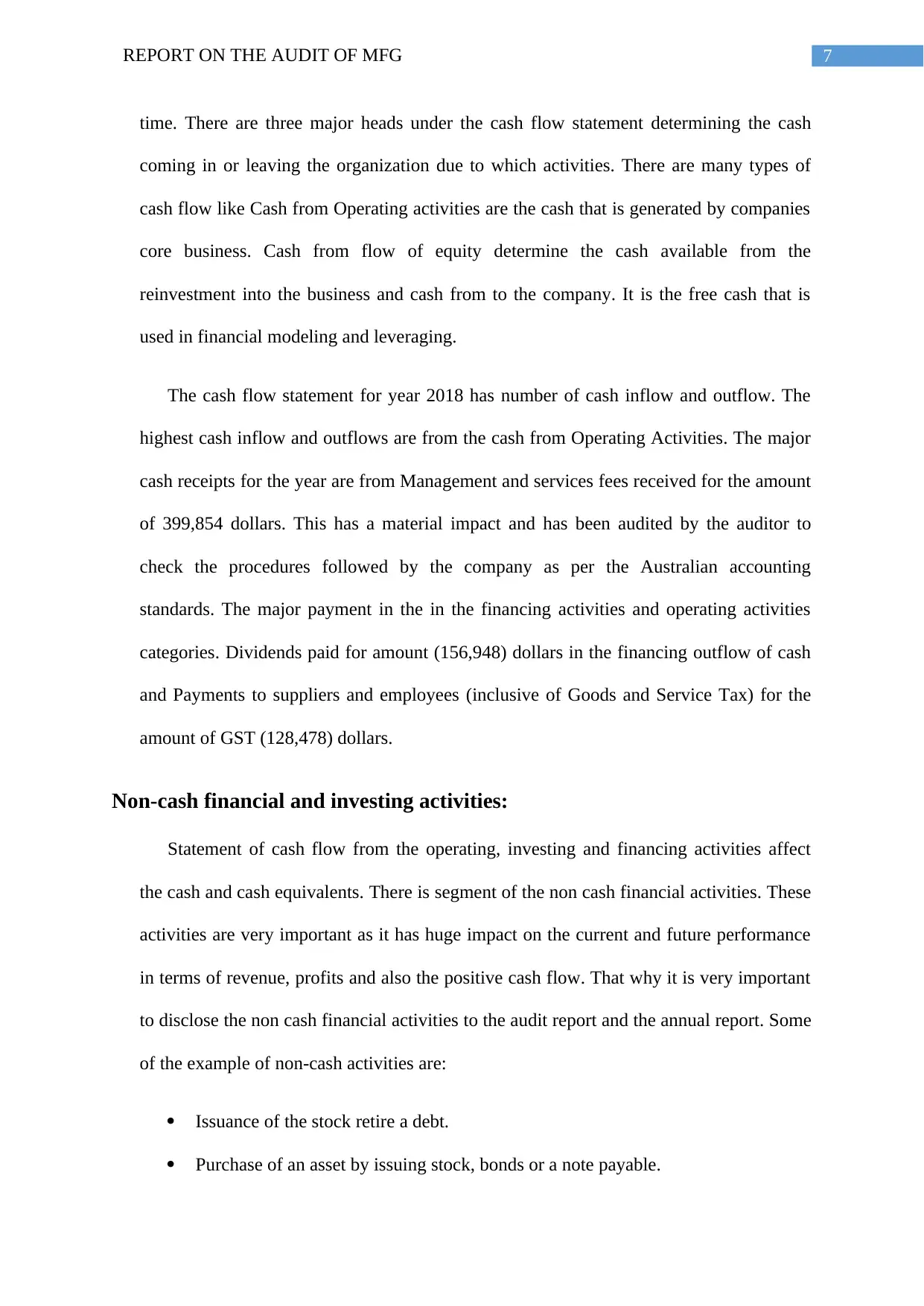
7REPORT ON THE AUDIT OF MFG
time. There are three major heads under the cash flow statement determining the cash
coming in or leaving the organization due to which activities. There are many types of
cash flow like Cash from Operating activities are the cash that is generated by companies
core business. Cash from flow of equity determine the cash available from the
reinvestment into the business and cash from to the company. It is the free cash that is
used in financial modeling and leveraging.
The cash flow statement for year 2018 has number of cash inflow and outflow. The
highest cash inflow and outflows are from the cash from Operating Activities. The major
cash receipts for the year are from Management and services fees received for the amount
of 399,854 dollars. This has a material impact and has been audited by the auditor to
check the procedures followed by the company as per the Australian accounting
standards. The major payment in the in the financing activities and operating activities
categories. Dividends paid for amount (156,948) dollars in the financing outflow of cash
and Payments to suppliers and employees (inclusive of Goods and Service Tax) for the
amount of GST (128,478) dollars.
Non-cash financial and investing activities:
Statement of cash flow from the operating, investing and financing activities affect
the cash and cash equivalents. There is segment of the non cash financial activities. These
activities are very important as it has huge impact on the current and future performance
in terms of revenue, profits and also the positive cash flow. That why it is very important
to disclose the non cash financial activities to the audit report and the annual report. Some
of the example of non-cash activities are:
Issuance of the stock retire a debt.
Purchase of an asset by issuing stock, bonds or a note payable.
time. There are three major heads under the cash flow statement determining the cash
coming in or leaving the organization due to which activities. There are many types of
cash flow like Cash from Operating activities are the cash that is generated by companies
core business. Cash from flow of equity determine the cash available from the
reinvestment into the business and cash from to the company. It is the free cash that is
used in financial modeling and leveraging.
The cash flow statement for year 2018 has number of cash inflow and outflow. The
highest cash inflow and outflows are from the cash from Operating Activities. The major
cash receipts for the year are from Management and services fees received for the amount
of 399,854 dollars. This has a material impact and has been audited by the auditor to
check the procedures followed by the company as per the Australian accounting
standards. The major payment in the in the financing activities and operating activities
categories. Dividends paid for amount (156,948) dollars in the financing outflow of cash
and Payments to suppliers and employees (inclusive of Goods and Service Tax) for the
amount of GST (128,478) dollars.
Non-cash financial and investing activities:
Statement of cash flow from the operating, investing and financing activities affect
the cash and cash equivalents. There is segment of the non cash financial activities. These
activities are very important as it has huge impact on the current and future performance
in terms of revenue, profits and also the positive cash flow. That why it is very important
to disclose the non cash financial activities to the audit report and the annual report. Some
of the example of non-cash activities are:
Issuance of the stock retire a debt.
Purchase of an asset by issuing stock, bonds or a note payable.
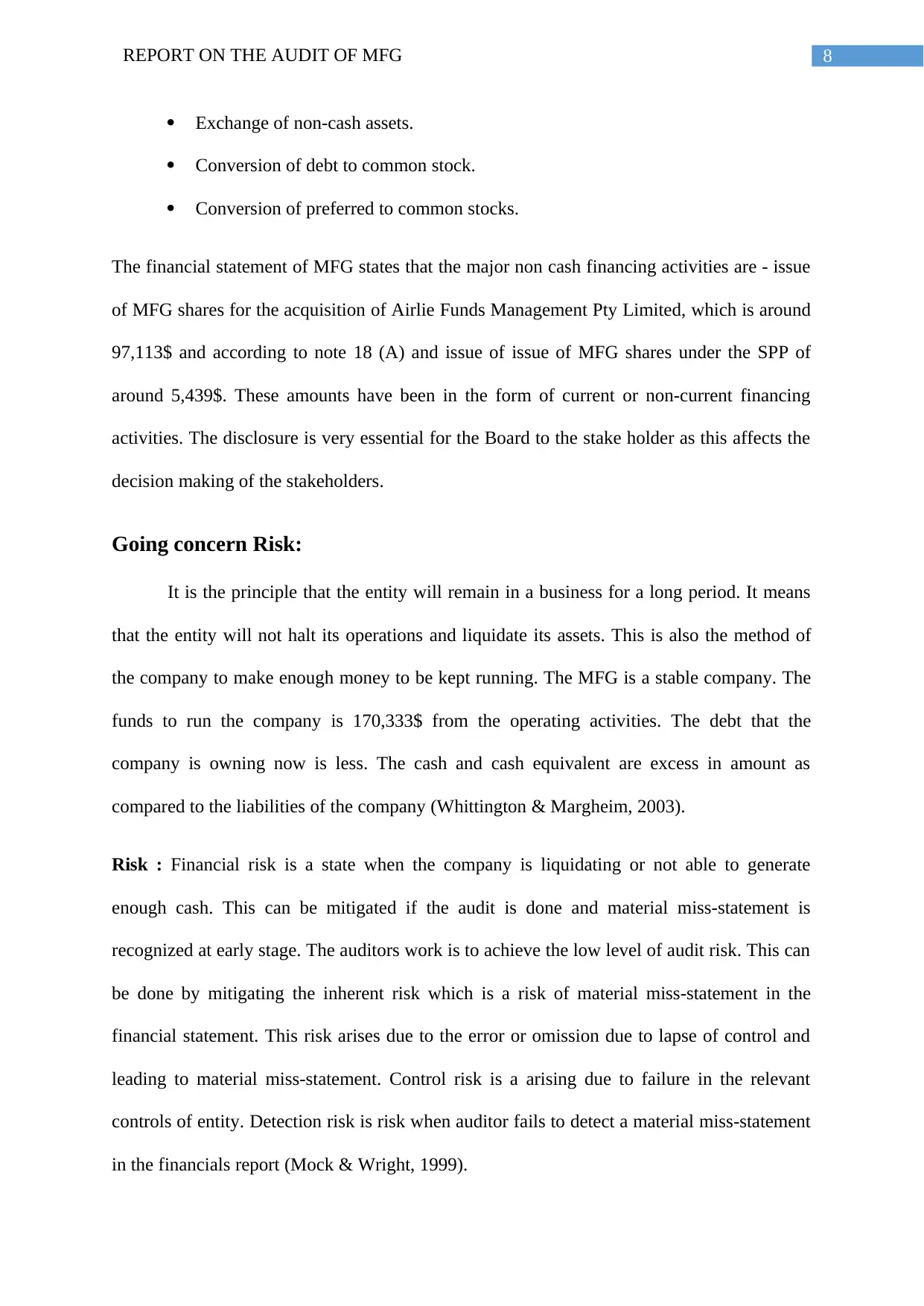
8REPORT ON THE AUDIT OF MFG
Exchange of non-cash assets.
Conversion of debt to common stock.
Conversion of preferred to common stocks.
The financial statement of MFG states that the major non cash financing activities are - issue
of MFG shares for the acquisition of Airlie Funds Management Pty Limited, which is around
97,113$ and according to note 18 (A) and issue of issue of MFG shares under the SPP of
around 5,439$. These amounts have been in the form of current or non-current financing
activities. The disclosure is very essential for the Board to the stake holder as this affects the
decision making of the stakeholders.
Going concern Risk:
It is the principle that the entity will remain in a business for a long period. It means
that the entity will not halt its operations and liquidate its assets. This is also the method of
the company to make enough money to be kept running. The MFG is a stable company. The
funds to run the company is 170,333$ from the operating activities. The debt that the
company is owning now is less. The cash and cash equivalent are excess in amount as
compared to the liabilities of the company (Whittington & Margheim, 2003).
Risk : Financial risk is a state when the company is liquidating or not able to generate
enough cash. This can be mitigated if the audit is done and material miss-statement is
recognized at early stage. The auditors work is to achieve the low level of audit risk. This can
be done by mitigating the inherent risk which is a risk of material miss-statement in the
financial statement. This risk arises due to the error or omission due to lapse of control and
leading to material miss-statement. Control risk is a arising due to failure in the relevant
controls of entity. Detection risk is risk when auditor fails to detect a material miss-statement
in the financials report (Mock & Wright, 1999).
Exchange of non-cash assets.
Conversion of debt to common stock.
Conversion of preferred to common stocks.
The financial statement of MFG states that the major non cash financing activities are - issue
of MFG shares for the acquisition of Airlie Funds Management Pty Limited, which is around
97,113$ and according to note 18 (A) and issue of issue of MFG shares under the SPP of
around 5,439$. These amounts have been in the form of current or non-current financing
activities. The disclosure is very essential for the Board to the stake holder as this affects the
decision making of the stakeholders.
Going concern Risk:
It is the principle that the entity will remain in a business for a long period. It means
that the entity will not halt its operations and liquidate its assets. This is also the method of
the company to make enough money to be kept running. The MFG is a stable company. The
funds to run the company is 170,333$ from the operating activities. The debt that the
company is owning now is less. The cash and cash equivalent are excess in amount as
compared to the liabilities of the company (Whittington & Margheim, 2003).
Risk : Financial risk is a state when the company is liquidating or not able to generate
enough cash. This can be mitigated if the audit is done and material miss-statement is
recognized at early stage. The auditors work is to achieve the low level of audit risk. This can
be done by mitigating the inherent risk which is a risk of material miss-statement in the
financial statement. This risk arises due to the error or omission due to lapse of control and
leading to material miss-statement. Control risk is a arising due to failure in the relevant
controls of entity. Detection risk is risk when auditor fails to detect a material miss-statement
in the financials report (Mock & Wright, 1999).
⊘ This is a preview!⊘
Do you want full access?
Subscribe today to unlock all pages.

Trusted by 1+ million students worldwide
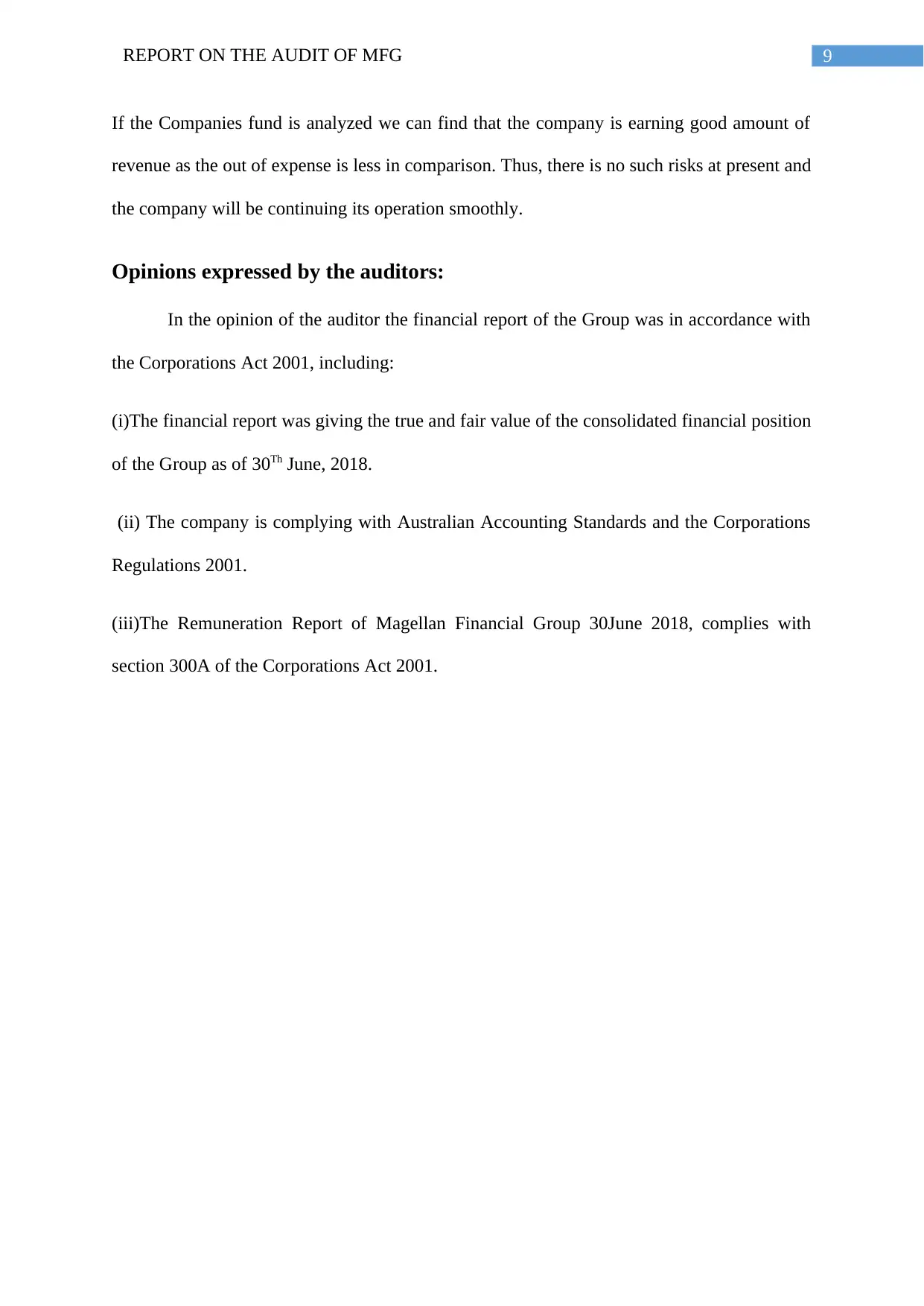
9REPORT ON THE AUDIT OF MFG
If the Companies fund is analyzed we can find that the company is earning good amount of
revenue as the out of expense is less in comparison. Thus, there is no such risks at present and
the company will be continuing its operation smoothly.
Opinions expressed by the auditors:
In the opinion of the auditor the financial report of the Group was in accordance with
the Corporations Act 2001, including:
(i)The financial report was giving the true and fair value of the consolidated financial position
of the Group as of 30Th June, 2018.
(ii) The company is complying with Australian Accounting Standards and the Corporations
Regulations 2001.
(iii)The Remuneration Report of Magellan Financial Group 30June 2018, complies with
section 300A of the Corporations Act 2001.
If the Companies fund is analyzed we can find that the company is earning good amount of
revenue as the out of expense is less in comparison. Thus, there is no such risks at present and
the company will be continuing its operation smoothly.
Opinions expressed by the auditors:
In the opinion of the auditor the financial report of the Group was in accordance with
the Corporations Act 2001, including:
(i)The financial report was giving the true and fair value of the consolidated financial position
of the Group as of 30Th June, 2018.
(ii) The company is complying with Australian Accounting Standards and the Corporations
Regulations 2001.
(iii)The Remuneration Report of Magellan Financial Group 30June 2018, complies with
section 300A of the Corporations Act 2001.
Paraphrase This Document
Need a fresh take? Get an instant paraphrase of this document with our AI Paraphraser
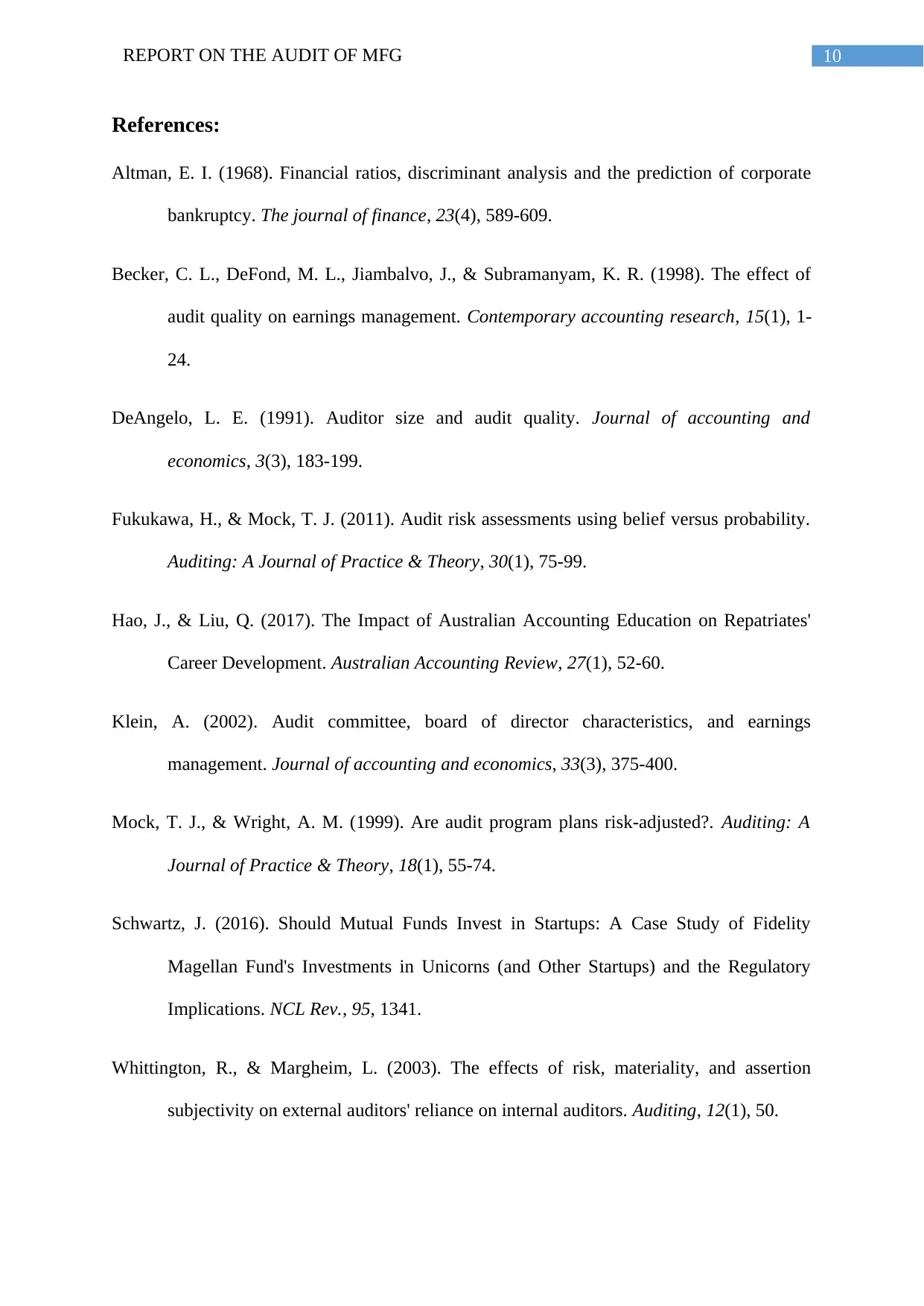
10REPORT ON THE AUDIT OF MFG
References:
Altman, E. I. (1968). Financial ratios, discriminant analysis and the prediction of corporate
bankruptcy. The journal of finance, 23(4), 589-609.
Becker, C. L., DeFond, M. L., Jiambalvo, J., & Subramanyam, K. R. (1998). The effect of
audit quality on earnings management. Contemporary accounting research, 15(1), 1-
24.
DeAngelo, L. E. (1991). Auditor size and audit quality. Journal of accounting and
economics, 3(3), 183-199.
Fukukawa, H., & Mock, T. J. (2011). Audit risk assessments using belief versus probability.
Auditing: A Journal of Practice & Theory, 30(1), 75-99.
Hao, J., & Liu, Q. (2017). The Impact of Australian Accounting Education on Repatriates'
Career Development. Australian Accounting Review, 27(1), 52-60.
Klein, A. (2002). Audit committee, board of director characteristics, and earnings
management. Journal of accounting and economics, 33(3), 375-400.
Mock, T. J., & Wright, A. M. (1999). Are audit program plans risk-adjusted?. Auditing: A
Journal of Practice & Theory, 18(1), 55-74.
Schwartz, J. (2016). Should Mutual Funds Invest in Startups: A Case Study of Fidelity
Magellan Fund's Investments in Unicorns (and Other Startups) and the Regulatory
Implications. NCL Rev., 95, 1341.
Whittington, R., & Margheim, L. (2003). The effects of risk, materiality, and assertion
subjectivity on external auditors' reliance on internal auditors. Auditing, 12(1), 50.
References:
Altman, E. I. (1968). Financial ratios, discriminant analysis and the prediction of corporate
bankruptcy. The journal of finance, 23(4), 589-609.
Becker, C. L., DeFond, M. L., Jiambalvo, J., & Subramanyam, K. R. (1998). The effect of
audit quality on earnings management. Contemporary accounting research, 15(1), 1-
24.
DeAngelo, L. E. (1991). Auditor size and audit quality. Journal of accounting and
economics, 3(3), 183-199.
Fukukawa, H., & Mock, T. J. (2011). Audit risk assessments using belief versus probability.
Auditing: A Journal of Practice & Theory, 30(1), 75-99.
Hao, J., & Liu, Q. (2017). The Impact of Australian Accounting Education on Repatriates'
Career Development. Australian Accounting Review, 27(1), 52-60.
Klein, A. (2002). Audit committee, board of director characteristics, and earnings
management. Journal of accounting and economics, 33(3), 375-400.
Mock, T. J., & Wright, A. M. (1999). Are audit program plans risk-adjusted?. Auditing: A
Journal of Practice & Theory, 18(1), 55-74.
Schwartz, J. (2016). Should Mutual Funds Invest in Startups: A Case Study of Fidelity
Magellan Fund's Investments in Unicorns (and Other Startups) and the Regulatory
Implications. NCL Rev., 95, 1341.
Whittington, R., & Margheim, L. (2003). The effects of risk, materiality, and assertion
subjectivity on external auditors' reliance on internal auditors. Auditing, 12(1), 50.

11REPORT ON THE AUDIT OF MFG
⊘ This is a preview!⊘
Do you want full access?
Subscribe today to unlock all pages.

Trusted by 1+ million students worldwide
1 out of 12
Related Documents
Your All-in-One AI-Powered Toolkit for Academic Success.
+13062052269
info@desklib.com
Available 24*7 on WhatsApp / Email
![[object Object]](/_next/static/media/star-bottom.7253800d.svg)
Unlock your academic potential
Copyright © 2020–2025 A2Z Services. All Rights Reserved. Developed and managed by ZUCOL.





